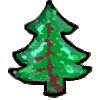Description:
Medium- sized leaves, more than 10 cm long and up to 3 cm wide, linear (fig.
2d), oblanceolate (fig. 2b), often symmetrical, curved, with pointed tip. Base
cuneiform (?). Margins even. Despite
a certain variation in the leaf outline, these leaves are here all assigned to
one species, as they occur together and have the same epidermal structure.
Venation not visible on the impressions and all we can judge is the arrangement
of the dorsal sulci. The order in which these branch at the base is unknown.
Most of the dichotomizing occurs in the inferior part of the leaf. 4 - 5 veins
per 0. 5 cm of leaf width.
Upper epidermis (pl. XIV, illus. , 3) consists of more or less regular
rows of circular-polygonal or elongate cells with thick walls. 14 cells per 0.5
mm of leaf width , 8- 14 cells per 0.5 mm of length. Two types of cell rows ar
e distinguished, one composed of elongate, longitudinally oriented, fusiform
cells up to 100µ long , with thinner walls , the other consisting of short, often prolate
cells, 30-60µ long, with
thicker walls . It is not always easy to demarcate the radial from the periclinal
wall in the upper epidermal cells . Dense cutinization overlaps the periclinal
wall , sometimes leaving only a small slit with rays running off from it. It is
not possible to distinguish rows of cells above the veins . Occasionally
secretory canals occur.
Cuticle very thick; nevertheless, the dorsal sulciare sometimes imprinted
through its thickness, producing prints in the form of double furrows on the
impression of the upper side of the leaf (pl. XIV, ilIus. 2). Dorsal sulci
clearly visible on the preparations (pl. XIV, ilIus. 4, 6), but sometimes their
margins come together and the sulci then look like cutinized strands. In Plate
XIV, illus. 6 and Figu re 3 it can be seen that the sulci become established
pair by pair, but that the members of each pair may form simultaneously or one
after the other. In some specimens successive pairs form so close together as
to give the probably. false impression of dichotomizing, (fig . 3b, bottom; fig
. Sa, top) .
The lower epidermis (p l. XIV, illus. 4-9) is slightly less cutinized
than the upper one. The space between the dorsal sulci is composed of the same
kind of cells as on the upper epidermis . These are 30-70µ long and 20 -50µ
wide. The dorsal sulci are 100-190µ wide, bordered on both sides by dense
cutinized strands, with thick papillae (or unicellular hairs), up to 50µ long,
running off from them in opposite directions . Stomata are pilosocytic (V.A .
Krasilov's terminology, 1968) ; that is, auxiliary cells have large, hairlike
processes up to 50µ long pendant above the stomatal pit (p l. XIV, illus. 5).
It is impossible to distinguish the outline of the auxiliary cells ; to judge from
the number of hairlike processes there must have been five or more . The inner space of the sulcus is
usually completely filled with the intertwined pilosity of these cells and with
papillae (Plate XIV, illus. 4 right), so that it is difficult to distinguish
the stomata. The
structure of the guard c ells is unknown.

Add new comment